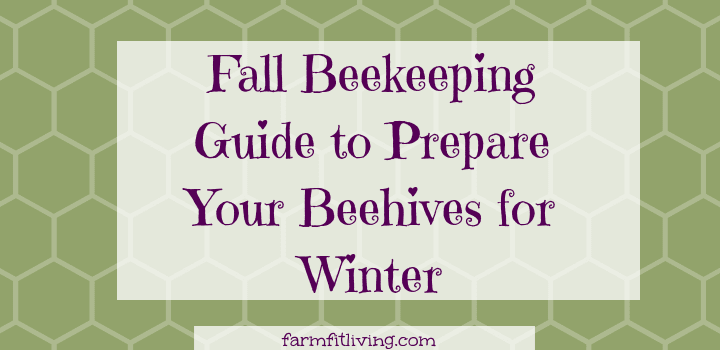Getting your hive prepared for winter can be a daunting task but with this fall beekeeping guide you’ll have the tips you need to have a successful winter.
This Fall beekeeping guide and podcast episode is all about how to prepare your bees for fall and what to watch for as you do.
In this episode you’ll find:
- Tasks to prep your bees for fall.
- Ways to help sustain your hive through winter.
- Ways to protect your hive through winter.
- Fall Beekeeping Guide.

Fall Beekeeping Guide
The first thing to keep in mind is that you want to have your tasks complete before the first frost. This is normally October here in Kansas, so it’s definitely something to start preparing for now. As fall approaches you’re going to notice that the hive will start to slow down and eventually stop laying eggs altogether.
You also may see your hive numbers decrease. As winter approaches the female bees will kick the drones (male bees) out of the hive since they don’t contribute anything to the hive and they’re extra mouths to feed. Most will likely die.
Another thing you’ll notice is a sticky substance on the outside and in the creases of your hives. This is called propolis and it is a substance that needs bring in to prep their hive for winter.
You’ll want to use your hive tool to get into your hive in September and you’re definitely going to want your smoker. As winter approaches bees tend to get more aggressive in order to protect their honey stores. Which is something else you’re going to need to watch for, other bees will try and come into the hive and steal the honey. I’ll be doing an episode on that and what that means for your hives soon.
There are four main tasks to prep your bees and hives for fall so let’s dive into those.
Fall Beekeeping Guide to Keep Bees Alive in Winter
Check for your queen.
You want to be sure you have your queen going into fall and winter. If you have a lot of bees and you’re not sure then you can check for eggs, if you see eggs then you know she laid them within the last three days.
Bee health
Your number one concern needs to be parasite control. You can read this post which goes into detail on the different parasites, what to look for, how to treat, etc.
Check your honey stores
The easiest way to check if there’s enough honey for your bees to survive off of for winter is to lift your hive. There should be 60 to 70 pounds of honey at least and you don’t want a lot of space. If there’s too much space in the hive it makes room for parasites and small hive beetles.
Plan on feeding your hive
I like to use a 2-to-1 sugar water ratio in external feeders. You’re going to want to check those feeders 2-3 times a week to be sure that they have enough for winter.
Candy boards
Late fall, or 40-50 degrees is the last time you want to be in the hive. You really want to have all this work complete before the lower temps start setting in. I make a hard sugar candy board that I put on top of my brood box. Then I put the outer cover on top and that helps keep them fed all winter. They’ll eat their honey stores first. The candy board is a lifesaver should they run out before it’s warm enough for them to go outside again.
Ventilate your hive
The thing about bees is that they cluster in the winter when it’s cold in their hive. Their cluster is 90 to 93 degrees Fahrenheit, which is fairly warm. When that heat rises and hits that cold inner cover, then condensation occurs. This causes cold moisture to fall into the hive and onto the bees. That’s when your bees will freeze to death.
That’s when bad things happen to the bees. They get wet and cold and they just can’t get warmed back up. So I’m going to touch on ventilation in a later episode. But one tip that I’ve seen a lot of is to turn your inner cover over and just play some wood chips or some wood shavings on the inside. That helps with ventilation.
You could also do a beehive insulation wrap with black tar paper. This will help regulate the temp and act as a windbreak. I have not personally done this because I don’t feel like the temperatures here in Kansas have gotten cold enough. The coolest that we get is about 10 or 15 below zero and my bees have always made it through the winter.
When to take honey supers off
So we just grabbed the supers off the hives and we take them in and then extract the honey into jars to enjoy for ourselves. That is another task that you’ll have to pay attention to if you’re hive is a little older.
Conclusion
This post has featured a fall beekeeping guide to prepare your beehives for winter during the fall to ensure the health of your hive. Check out the resources below for more tips and tricks for managing your hive year round. Also check out my Facebook Group: Surviving the First Year of Beekeeping.
Resources:
Start Beekeeping with Little Money
Control Wax Moths in Bee Hives
How to Make Candy Boards for Bee Hives
Beekeeping Hive Inspection Printable Sheets


